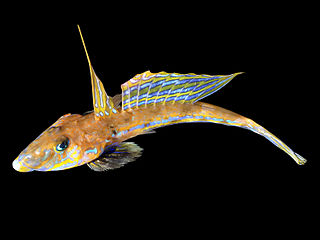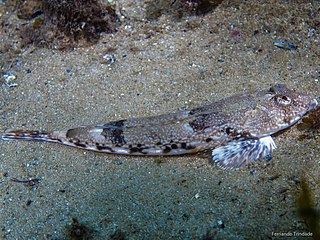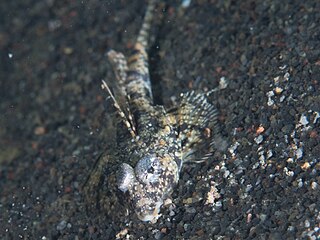
Dragonets are small, percomorph, marine fish of the diverse family Callionymidae found mainly in the tropical waters of the western Indo-Pacific. They are benthic organisms, spending most of their time near the sandy bottoms, at a depth of roughly two hundred meters. There exist 139 species of the fish, in nineteen genera.

Callionymus is a genus of dragonets found mostly in the Indian and Pacific oceans with a few species occurring in the Atlantic Ocean.

The lancer dragonet, Baird's dragonet, coral dragonet or St Helena dragonet, is a species of dragonet native to the warmer waters of the Atlantic Ocean where it occurs at depths of from 1 to 91 metres. In the western Atlantic it occurs from Cape Hatteras southwards along the east coast of North America. including Bermuda and the Bahamas, into the Gulf of Mexico and throughout the Caribbean Sea. It has also been recorded from Ilha da Trindade off Brazil. In the eastern Atlantic it has been recorded from the Cape Verde Islands, Ascension Island, St. Helena, and Sao Tome e Principe in the Gulf of Guinea. This species grows to a length of 11.4 centimetres (4.5 in) TL.
Callionymus bleekeri, Bleeker's deepwater dragonet, is a species of dragonet endemic to the Pacific Ocean waters around Indonesia. The specific name honours the Dutch ichthyologist and surgeon Pieter Bleeker (1819-1878).
Callionymus colini, the Tiny New Guinea longtail dragonet, is a species of dragonet endemic to the Pacific Ocean waters around Papua New Guinea. The specific name honours Dr Patrick L. Colin, of the University of Papua New Guinea's Motupore Island Research Station in Port Moresby, who collected the type specimen.
The longtail dragonet is a species of dragonet native to the western Indian Ocean. It can be found at depths of from 30 to 180 metres. This species grows to a length of 28 centimetres (11 in) TL. The specific name honours the British zoologist John Stanley Gardiner (1872-1946).
Callionymus hildae, Hilde's darter dragonet, is a species of dragonet endemic to the Pacific waters around the Philippines. The specific name honours Miss Hildegard Handermann, of Braunschweig, for her "continued interest" in the author's, Ronald Fricke's, studies.
Callionymus kailolae, Kailola's deepwater dragonet or the Northwestern ocellated dragonet, is a species of dragonet native to the Indian Ocean off of western Australia where this deep-water species is found at depths of from 200 to 204 metres. The specific name honours Patricia Kailola of Newnham, Tasmania who published a photograph of the new species, "in appreciation of her interest in callionymid fish research".
Callionymus keeleyi, Keeley's dragonet, is a species of dragonet native to the western Pacific Ocean where it is known to occur near the Philippines and Papua New Guinea. The specific name honours Frank James Keeley (1868-1949) of the department of mineralogy, Academy of Natural Sciences, Philadelphia.

The common dragonet is a species of dragonet which is widely distributed in the eastern North Atlantic where it is common near Europe from Norway and Iceland southwards. It is a demersal species that occurs over sand bottoms. It lives to a maximum age of around seven years. It is caught in bycatch by fisheries and is used in the aquarium trade.
Callionymus martinae, Martina's dragonet, is a species of dragonet endemic to the Pacific waters around Taiwan where it occurs at depths of from 73 to 92 metres. The specific name honours Miss Martina Wolf, of Braunschweig, for her "continued interest" in the author's, Ronald Fricke's, studies.
Callionymus ochiaii, the Japanese lowfin deepwater dragonet, is a species of dragonet found in the Pacific waters around Japan. The specific name honours the Japanese ichthyologist Akira Ochiai.
Callionymus ogilbyi, the Eastern Australian longtail dragonet, is a species of dragonet endemic to the Pacific waters off of New South Wales, Australia. The specific name honours the Irish-Australian zoologist and taxonomist James Douglas Ogilby (1853-1925).

The Sailfin dragonet is a species of dragonet common in the Eastern Atlantic, where it occurs on the Portuguese coast to as far north as Lisbon and south to Morocco, and also in the northern Mediterranean including the Adriatic, Aegean and Black seas as well as the coastsLebanon and Israel. It occurs on the southern Mediterranean shore as far east as Tunisia Males of this species grows to a length of 14 centimetres (5.5 in) TL while females reach a length of 10 centimetres (3.9 in) TL. In the areas of the Mediterranean where it occurs it is one of the commonest dragonet species, as it is the only species that has been recorded within many protected areas. It is a benthic species which occurs in shallow waters and prefers sandy bottoms down to 100 metres (330 ft). The males are territorial, aggressively defend their territories from other males and like other dragonets this species undergoes complex breeding behaviour which has 4 phases. This starts with courtship, the male and female then form a pair before ascending to the surface where they release eggs and milt. The spawning season runs from May to August in the Mediterranean and the eggs and larvae are pelagic. This species feeds mainly on small benthic invertebrates such as worms and small crustaceans.
Callionymus regani, Regan’s deepwater dragonet, is a species of dragonet known only from the Saya de Malha Bank in the Indian Ocean at depths of around 148 metres (486 ft). The specific name honours the British ichthyologist Charles Tate Regan (1878-1943).

The reticulated dragonet is a species of dragonet native to the northeastern Atlantic Ocean and the Mediterranean Sea where it is found at depths of from 0 to 110 metres. This species grows to a length of 11 centimetres (4.3 in) TL. This species has a flattened head and body, the head has a triangular shape with the eyes placed on the top of the head. It has two dorsal fins with the first one being triangular in shape. It has blue spots along the flanks and four saddle-like markings on their backs which have sharply defined outlines. It is similar to the common dragonet but is distinguished by its smaller size and the sharply defined border around the saddle markings on the back.
Callionymus russelli, Russell’s dragonet, is a species of dragonet native to the Pacific waters off of Papua New Guinea.

The arrow dragonet, also known as the arrow-headed darter dragonet, is a species of dragonet widespread in the Indo-West Pacific from Arabian Peninsula to the Philippines. Occurs in the Mekong delta of Viet Nam and probably also in Cambodia. This species grows to a length of 11 centimetres (4.3 in) TL. The arrow dragonet is a demersal species, which occurs on sandy substrates along coastlines, in estuaries, and in the lower courses of rivers where it feeds on worms, zooplankton and phytoplankton.

Callionymus superbus, the proud dragonet or superb dragonet, is a species of dragonet native to the western Pacific Ocean where it occurs down to depths of 25 metres (82 ft). This species grows to a length of 20 centimetres (7.9 in) TL.
Callionymus whiteheadi, Whitehead's deepwater dragonet, is a species of dragonet found in the Pacific waters around Indonesia. The specific name honours the ichthyologist Peter James Palmer Whitehead (1930-1992).






